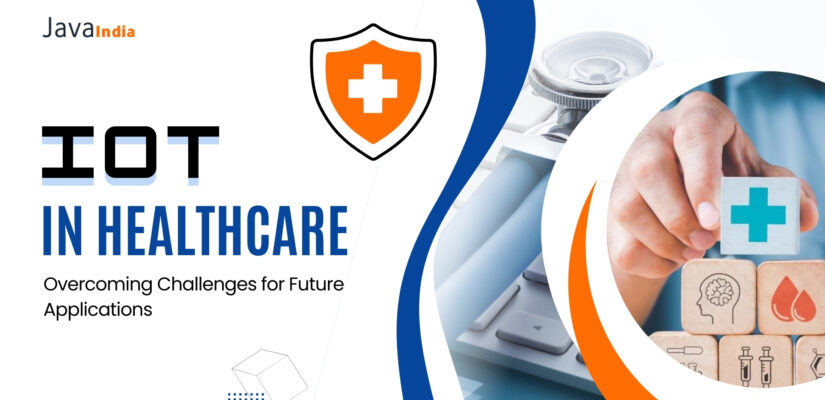
IoT in Healthcare: Overcoming Challenges for Future Applications
By 2024, IoT technology will have completely changed healthcare by improving patient care and organizational effectiveness. However new difficulties appear as healthcare gets more integrated. The features, advantages, developments, and challenges of IoT in healthcare are explored in this blog, along with workable solutions to these problems.
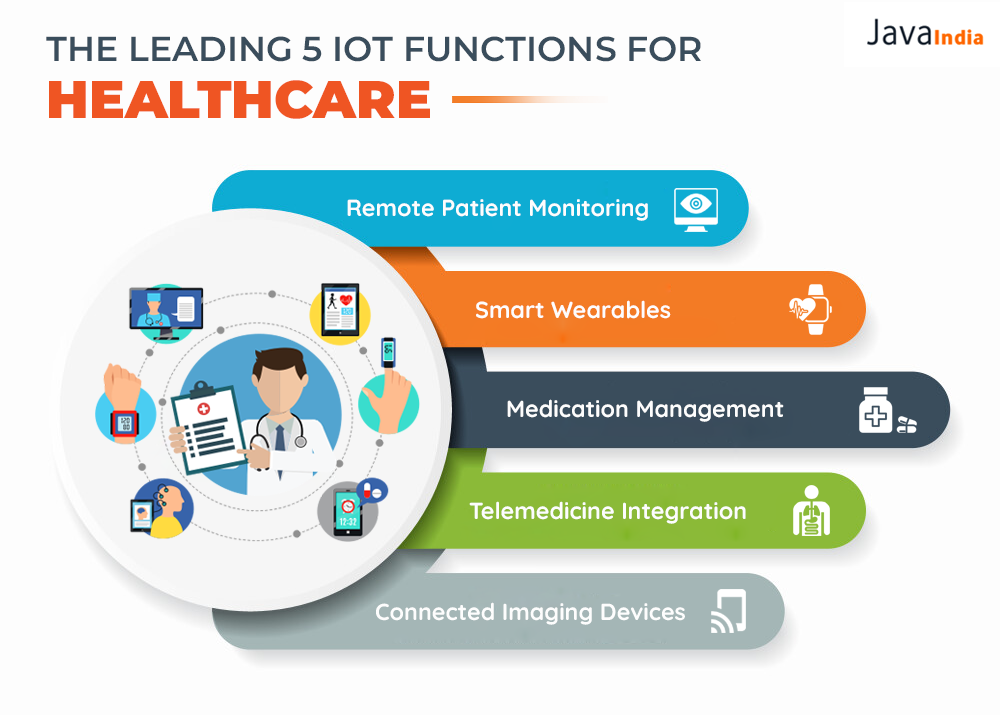
The Leading 5 IoT Functions for Healthcare
1. Remote Patient Monitoring: Vital signs like blood sugar and heart rate are continuously monitored by IoT devices. As a result, medical professionals can act quickly to provide the required care.
2. Smart Wearables: Health data is gathered by fitness trackers and related devices, enabling proactive health management. Patients thus get timely updates regarding their state of health.
3. Medication Management: Medication errors can be decreased and compliance can be increased with the use of automated reminders and adherence monitoring systems. Thus, there is a notable improvement in patient safety.
4. Telemedicine Integration: Regardless of location, IoT allows for virtual communication between patients and medical professionals. Access to medical care is substantially improved by this integration.
5. Connected Imaging Devices: AI-driven analysis enhances the diagnostic accuracy of advanced imaging equipment driven by IoT. As a result, better diagnosis and treatment planning are achieved.
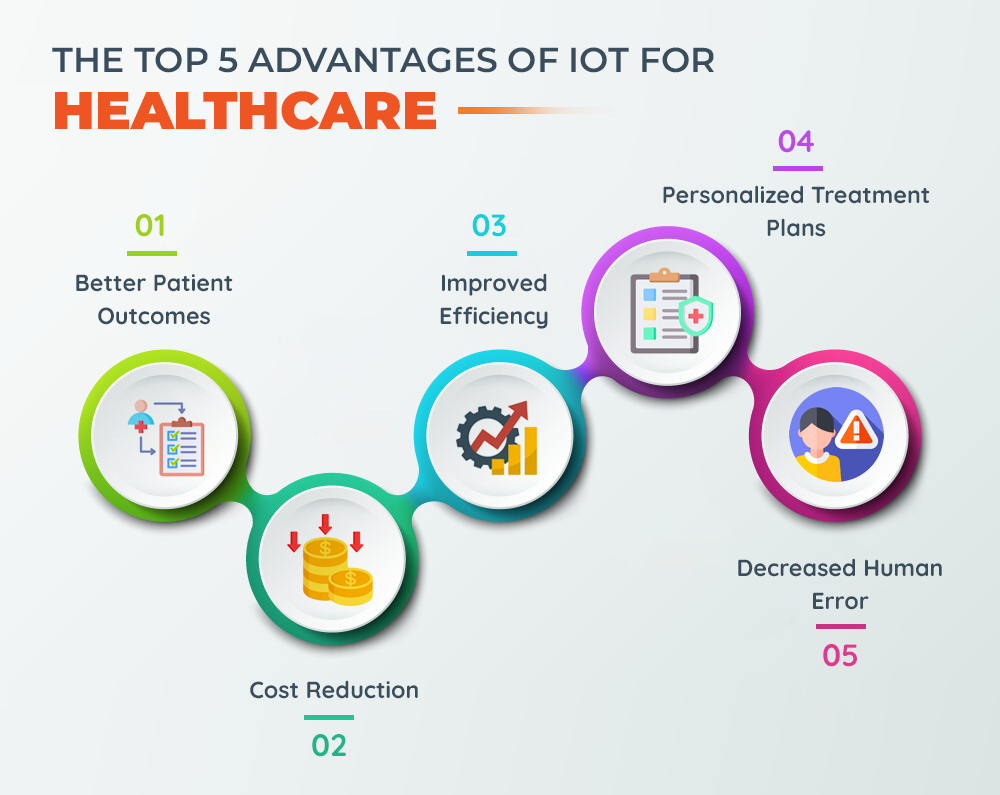
The Top 5 Advantages of IoT for Healthcare
Better Patient Outcomes:
Real-time data allows for timely action; it enhances patients’ condition. Relative to that, there has been a dye-in-the-wool, 30 percent reduction in the cases of readmission to the hospital, following utilization of the remote monitoring devices.
Cost Reduction:
Therefore, remote monitoring patients’ activity may lead to decreasing the total expenditures of approximately 25% through lowering the number of inpatient visits. Therefore, patients are relieved the financial burden while the providers are not financially stressed as before.
Improved Efficiency:
Healthcare personnel may deal with other meaningful tasks if procedures are integrated and/or made more efficient through automation. The seen outcome of this development is an enhancement of the quality of care.
Personalized Treatment Plans:
Ongoing data gathering allows customized treatment plans to be created, which improves the therapy’s efficacy. More precise and tailored care is advantageous to patients.
Decreased Human Error:
Automation reduces medication and treatment mistakes, enhancing patient security and caliber of care. As a result, there is much less chance of errors.
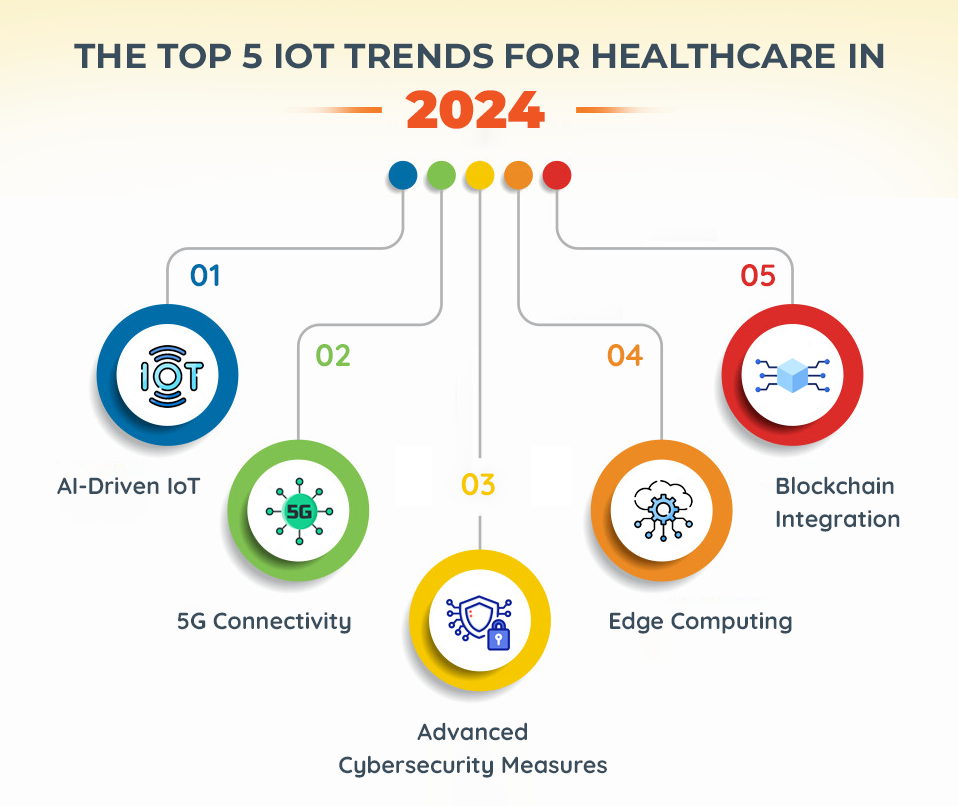
The Top 5 IoT Trends for Healthcare in 2024
1. AI-Driven IoT:
By enhancing diagnostic precision and predictive analytics, AI improves patient care. Healthcare professionals can now provide treatments that are more accurate and timelier.
2. 5G Connectivity:
Real-time monitoring requires faster and more dependable data transmission, which 5G networks provide. Java Web Application Development consequently, uses IoT applications to become more efficient and responsive.
3. Blockchain Integration:
Blockchain technology secures data transfers, addressing privacy concerns and improving data integrity. Therefore, patient data remains secure and tamper-proof.
4. Edge Computing:
Edge computing processes data closer to the source, lowering latency and boosting IoT performance. This improvement leads to more efficient real-time data analysis.
5. Advanced Cybersecurity Measures:
New security protocols and encryption techniques protect health data from breaches. Java Mobile App Development consequently, checks risk of data theft and unauthorized access is minimized.
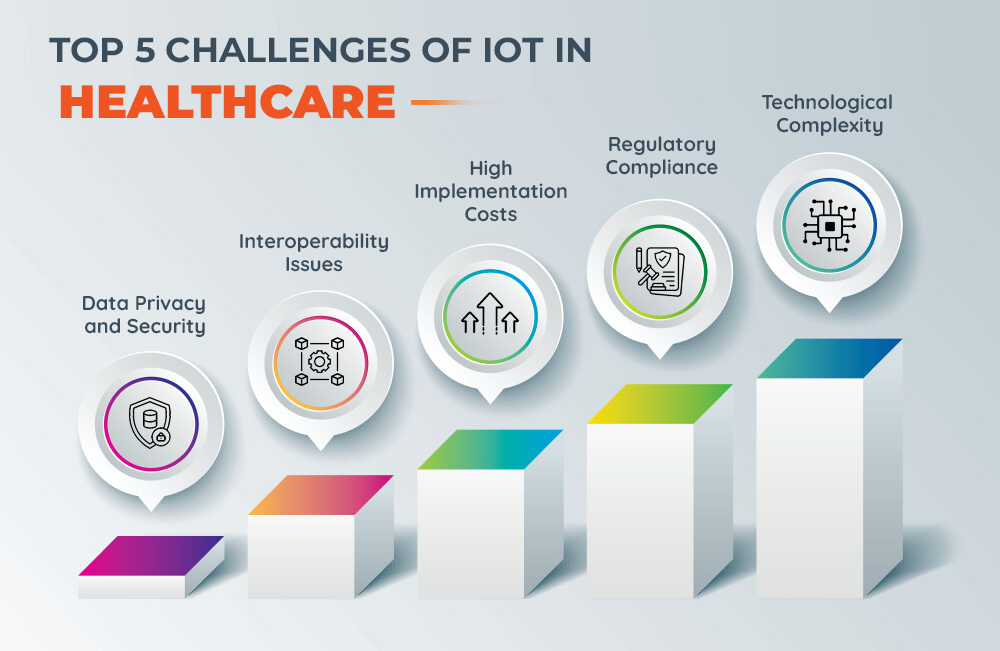
Top 5 Challenges of IoT in Healthcare
1. Data Privacy and Security: Ensuring the privacy of patient data is vital, and breaches may have catastrophic implications. Hence, rigorous security measures are important to secure critical information.
2. Interoperability Issues: Integration challenges develop when various IoT devices fail to operate together, hindering data transmission. Thus, creating interoperability standards is vital for easy integration.
3. High Implementation Costs: The initial expenditure needed for IoT technology might be large. Therefore, evaluating financing possibilities and performing cost-benefit assessments are crucial for controlling expenditures.
4. Regulatory Compliance: Navigating complicated rules is important for authorized IoT implementation. Legal and successful implementation depends on regulatory standards being met.
5. Technological Complexity: Advanced IoT system implementation calls for a high level of technological proficiency. Therefore, continuing assistance and training are required for effective adoption.
Overcoming Healthcare IoT Challenges
1. Enhanced Cybersecurity Measures: Implementing multi-factor authentication and powerful encryption helps secure patient data. Consequently, the possibility of data leaks is lowered.
2. Standardization of IoT Protocols: Developing global standards promotes device integration and interoperability. Thus, data interchange becomes more fluid and efficient.
3. Government assistance and Funding: Seeking financial assistance might help mitigate the expenses of using IoT technology. As a consequence, corporations may invest in modern technology more readily.
4. Continuous Training and Education: Providing frequent training for healthcare personnel enables optimal administration of IoT systems. This method promotes technology uptake and use.
5. Stakeholder Collaboration: Collaboration among developers, providers, and regulators tackles obstacles and assures safe IoT deployment. Consequently, IoT’s overall efficacy in healthcare has gained momentum.
Study Cases
1. Remote Monitoring for Chronic Disease Management –
Problem: A network of hospitals had a high incidence of readmission for patients with chronic conditions.
Remedy: deployed an Internet of Things (IoT)-based remote monitoring system to continuously track health.
Result: Java app testing saw a 30% decrease in readmissions, which raised patient satisfaction and cut expenses.
2. Intelligent Wearables for Diabetes Management –
Issue: Variable monitoring made it difficult to control blood sugar levels in diabetic patients.
Remedy: introduced wearable smart devices to exchange data in real-time and monitor blood sugar continuously.
Result: Better glucose control and a 25% decrease in complications improved overall patient health.
3. Telemedicine for Remote Healthcare –
Issue: Insufficient availability of specialized care in remote regions affected patient results.
Remedy: Hire Java Developers they help install a telemedicine platform for remote diagnosis and online consultations based on the IoT Development.
Result: Increased early diagnosis rates by 40%, improving patient outcomes and expanding access to care.
Final Thoughts
IoT is revolutionizing the healthcare business by cutting costs, boosting efficiency, and improving patient care. Despite problems such as data security, interoperability, and high implementation costs, overcoming these concerns via sophisticated technology and collaborative efforts will unleash IoT’s full potential. Java Development Company In the healthcare industry, optimizing IoT utilization is essential to attaining operational success and improving patient care.
FAQ
Q. What does IoT mean for healthcare?
Ans. Wearables and remote monitoring tools are examples of linked gadgets that are used in the healthcare industry to monitor and manage patient health.
Q. What advantages can IoT provide the healthcare industry?
Ans. The main advantages include better patient outcomes, lower expenses, more effectiveness, individualized treatment, and fewer mistakes.
Q. What difficulties does IoT have in the medical field?
Ans. Difficulties include technical complexity, high prices, regulatory compliance, interoperability problems, and data privacy.
Q. How can these issues be resolved?
Ans. Cooperation among stakeholders, personnel training, financing assistance, standardization, and increased security measures are some of the solutions.
Q. Could you provide any instances of IoT applications that have been successful in the healthcare industry?
Ans. Some examples include better diabetes control with wearables, fewer readmissions with remote monitoring, and more early diagnosis with telemedicine.

